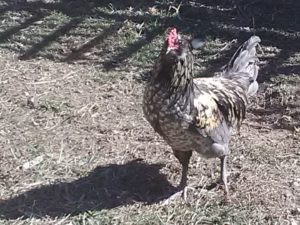Respiratory Infection & Coccidiosis in Chickens
Egg production is slowly starting to pick up again after a long month of illness in our chickens and losing one of our hens. I’m writing this post hoping it helps somebody else not make the same mistakes I made.
 About two weeks after moving our hens to the country with us I had the opportunity to add a young rooster to the flock, something I had been looking forward to. Less than a week later the first hen was showing signs of a respiratory infection.
About two weeks after moving our hens to the country with us I had the opportunity to add a young rooster to the flock, something I had been looking forward to. Less than a week later the first hen was showing signs of a respiratory infection.
This is my list of mistakes:
- I’m sure the move was stressful to the girls, it most likely lowered their immune system a bit, adding the new rooster didn’t help.
- I didn’t quarantine the rooster for a week or two first. We just moved and barely had time to get the new coop and run up, we didn’t have a place to quarantine him, not that that’s a good excuse.
- I made the mistake of assuming the respiratory infection was the main issue, when in reality it was a secondary infection, and coccidiosis was the main culprit. I lost valuable treatment time, and a hen who probably would have survived, had I started treating for coccidiosis immediately. I noticed they had some yellow diarrhea, a classic sign of coccidiosis, but I was focused on the respiratory infection part of it.
I researched respiratory infections in chickens for hours, there are a lot of causes, and a lot of the symptoms sounded the same which wasn’t helpful. As they got sick, we brought the girls in the house and kept them in dog crates, encouraging them to drink water I had put some Durastat with Oregano in. We monitored their breathing and tried to get them to eat, although there was little interest in food most of the time.
Coccidiosis is a protozoa that affects their digestive tract, causing inflammation and hemorrhaging, loss of appetite, diarrhea, blood or mucus in the feces. They are listless, they’re feathers are ruffled up like they are cold, and with the respiratory infection they are coughing, sneezing, and wheezing when they breathe. Mine didn’t want their normal feed or mealworm treats, when I could get them to eat it was something soft and easy to digest, like cantaloupe, watermelon, apple, kale, or scrambled eggs. There are about 9 different strains of coccidiosis, and a flock can gradually build up immunity to a strain they are exposed to, but when a new strain is brought in that they haven’t been exposed to before it can quickly spread and become deadly.
After we lost one of our hens a friend suggested it might be coccidiosis, and I began treating with liquid Corid, adding about 2 tsp. per gallon of water for 5 days, I added this to their morning water. I also soaked the cantaloupe and watermelon in this water before feeding it, as this was about the only thing the sickest of the remaining hens would eat or drink. Corid is marketed as a bovine product, but is safe to use with chickens, it kills all the strains that affect chickens, and there is no egg withdrawal period, if your hens are even still laying eggs, most don’t when they’re sick. I read the liquid mixes in water easier than the powder, so that’s what I used.
At the evening feeding I would change out the water to a solution of 1 tsp. apple cider vinegar in a gallon of water. I sprinkled Probios probiotics in their food and on the fruit before feeding as well.
Extreme heat and cold will kill the coccidiosis, while moist and dirty environments give it a place to grow. Keep pens and coops clean, rotate the chickens around instead of keeping them in one location if you can should help prevent reinfection.
There’s plenty of reading to do on the subject if you want to research it more, I would highly recommend it, I just wanted to share my experience and what worked for me. I hope it helps.
Related reading:
https://www.mailorderpoultry.com/coccidiosis-in-chickens-symptoms-cures-prevention/
https://www.countryfarm-lifestyles.com/coccidiosis-in-chickens-and-corid.html#.XratPmhKiUn
